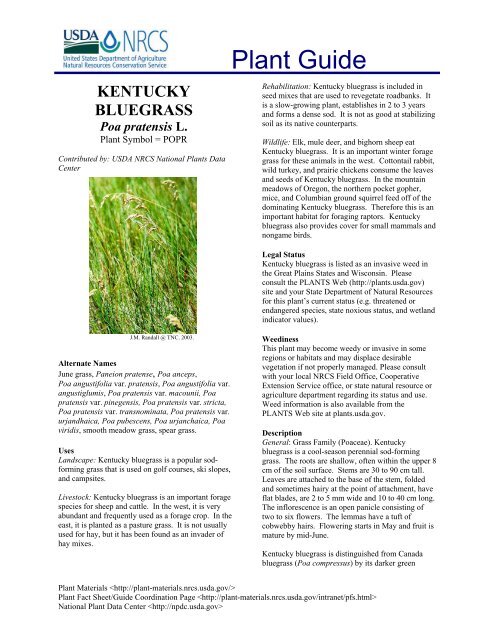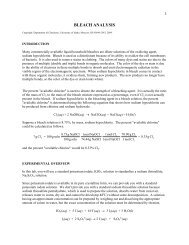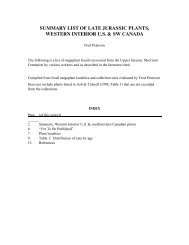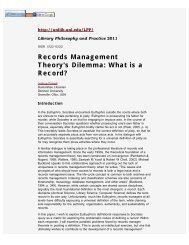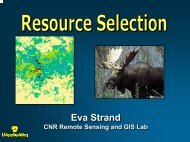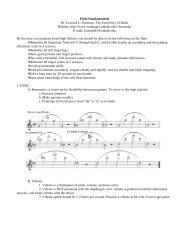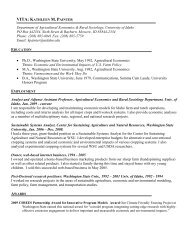Kentucky Bluegrass (Poa pratensis) - Star Seed Inc.
Kentucky Bluegrass (Poa pratensis) - Star Seed Inc.
Kentucky Bluegrass (Poa pratensis) - Star Seed Inc.
- No tags were found...
Create successful ePaper yourself
Turn your PDF publications into a flip-book with our unique Google optimized e-Paper software.
KENTUCKYBLUEGRASS<strong>Poa</strong> <strong>pratensis</strong> L.Plant Symbol = POPRContributed by: USDA NRCS National Plants DataCenterPlant GuideRehabilitation: <strong>Kentucky</strong> bluegrass is included inseed mixes that are used to revegetate roadbanks. Itis a slow-growing plant, establishes in 2 to 3 yearsand forms a dense sod. It is not as good at stabilizingsoil as its native counterparts.Wildlife: Elk, mule deer, and bighorn sheep eat<strong>Kentucky</strong> bluegrass. It is an important winter foragegrass for these animals in the west. Cottontail rabbit,wild turkey, and prairie chickens consume the leavesand seeds of <strong>Kentucky</strong> bluegrass. In the mountainmeadows of Oregon, the northern pocket gopher,mice, and Columbian ground squirrel feed off of thedominating <strong>Kentucky</strong> bluegrass. Therefore this is animportant habitat for foraging raptors. <strong>Kentucky</strong>bluegrass also provides cover for small mammals andnongame birds.Legal Status<strong>Kentucky</strong> bluegrass is listed as an invasive weed inthe Great Plains States and Wisconsin. Pleaseconsult the PLANTS Web (http://plants.usda.gov)site and your State Department of Natural Resourcesfor this plant’s current status (e.g. threatened orendangered species, state noxious status, and wetlandindicator values).J.M. Randall @ TNC. 2003.Alternate NamesJune grass, Paneion pratense, <strong>Poa</strong> anceps,<strong>Poa</strong> angustifolia var. <strong>pratensis</strong>, <strong>Poa</strong> angustifolia var.angustiglumis, <strong>Poa</strong> <strong>pratensis</strong> var. macounii, <strong>Poa</strong><strong>pratensis</strong> var. pinegensis, <strong>Poa</strong> <strong>pratensis</strong> var. stricta,<strong>Poa</strong> <strong>pratensis</strong> var. transnominata, <strong>Poa</strong> <strong>pratensis</strong> var.urjandhaica, <strong>Poa</strong> pubescens, <strong>Poa</strong> urjanchaica, <strong>Poa</strong>viridis, smooth meadow grass, spear grass.UsesLandscape: <strong>Kentucky</strong> bluegrass is a popular sodforminggrass that is used on golf courses, ski slopes,and campsites.Livestock: <strong>Kentucky</strong> bluegrass is an important foragespecies for sheep and cattle. In the west, it is veryabundant and frequently used as a forage crop. In theeast, it is planted as a pasture grass. It is not usuallyused for hay, but it has been found as an invader ofhay mixes.WeedinessThis plant may become weedy or invasive in someregions or habitats and may displace desirablevegetation if not properly managed. Please consultwith your local NRCS Field Office, CooperativeExtension Service office, or state natural resource oragriculture department regarding its status and use.Weed information is also available from thePLANTS Web site at plants.usda.gov.DescriptionGeneral: Grass Family (<strong>Poa</strong>ceae). <strong>Kentucky</strong>bluegrass is a cool-season perennial sod-forminggrass. The roots are shallow, often within the upper 8cm of the soil surface. Stems are 30 to 90 cm tall.Leaves are attached to the base of the stem, foldedand sometimes hairy at the point of attachment, haveflat blades, are 2 to 5 mm wide and 10 to 40 cm long.The inflorescence is an open panicle consisting oftwo to six flowers. The lemmas have a tuft ofcobwebby hairs. Flowering starts in May and fruit ismature by mid-June.<strong>Kentucky</strong> bluegrass is distinguished from Canadabluegrass (<strong>Poa</strong> compressus) by its darker greenPlant Materials Plant Fact Sheet/Guide Coordination Page National Plant Data Center
foliage, longer leaves, and pubescence at the bases ofthe leaves.Distribution: <strong>Kentucky</strong> bluegrass is native to portionsof North America, including areas within the UnitedStates. Exact delineation of native status has notbeen determined, but data seems to indicate that it isnative in parts of the southeast, northeast, and upperMidwest regions and introduced or naturalizedelsewhere. It occurs throughout the United Statesalthough it is most prevalent in the northern half. Itis not common in the Gulf States or in the desertregions of the southwest. For current distribution,please consult the Plant Profile page for this specieson the PLANTS Web site (http://plants.usda.gov).Habitat: <strong>Kentucky</strong> bluegrass is promoted on sitesthat have cool and humid climates. It is found inuplands and lowlands of the tallgrass prairie and inthe lowlands of mixed-grass prairies where adequateprecipitation falls. In the west, it is found onnorthern exposures at mid to high elevations. In thesouthwest and California, it is found in coolmountainous regions.It frequently occurs as an understory dominant inaspen habitats throughout the Intermountain Region,ponderosa pine, sagebrush/bunchgrass, andbunchgrass habitats throughout the U.S., and riparianhabitats in the Mountain West. It is also a commondominant of Midwestern prairies.Adaptation<strong>Kentucky</strong> bluegrass is found most abundantly on sitesthat are cool and humid. It has become naturalizedacross North America and often occurs as a dominantspecies in the herbaceous layer.<strong>Kentucky</strong> bluegrass grows best on well-drainedloams or clay loams rich in humus and on soils withlimestone parent material. It needs large amounts ofnitrogen during active growth stages. The optimalsoil pH is between 5.8 and 8.2.In the Blue Mountains of eastern Oregon andsoutheastern Washington, <strong>Kentucky</strong> bluegrassdominance is an indicator of dry to moist meadowconditions and of soils that are dark brown to blackand clayey.<strong>Kentucky</strong> bluegrass plants that have shorter leavesare more likely to produce tillers. Plants that occur infull sun have shorter leaves while those in shade haveleaves longer than the stems. Therefore plants thatare in full sun will produce more tillers and spreadmore quickly than those in the shade.<strong>Kentucky</strong> bluegrass is intolerant of drought,excessive flooding, high water tables, and poorlydrained soils.EstablishmentFor lawn establishment, plant 2 to 3 pounds of seedper 1,000 square feet. <strong>Seed</strong>ing rates are reducedwhen seed is drilled into the top 1 inch of soil.<strong>Kentucky</strong> bluegrass can be seeded year-round, butthe best results are obtained in the spring and fall.<strong>Seed</strong>s require light and frequent watering (2 to 3times per day for the first 2 weeks) for germination tooccur. After seedling emergence, watering frequencycan be reduced.ManagementThe active growth stage of <strong>Kentucky</strong> bluegrassbegins in late winter/early spring. By midsummer, itis nearly dominant on its sites. Cool temperatures infall promote growth when other species are dyingback. It spreads by rhizomes, produces abundantseed, and can become established on disturbed sitesfaster than other plant species. It is an aggressivecompetitor with native species.Total replacement of <strong>Kentucky</strong> bluegrass by nativesis labor-intensive and impractical. It is best tomanage for warm season native grasses rather thanagainst <strong>Kentucky</strong> bluegrass. In grasslands, atrazineand glyphosphate are effective herbicides fordecreasing <strong>Kentucky</strong> bluegrass abundance whenapplied prior to seeding warm-season native grasseslike big bluestem. Also, irregular spring and fallburns can help to control or maintain co-dominanceof <strong>Kentucky</strong> bluegrass (as opposed to completedominance).<strong>Kentucky</strong> bluegrass pastures are best managed undera grazing system other than season-long use. At theend of the growing season, it becomes less palatableand protein and fiber contents decline.Pests and Potential ProblemsWhite grubs, billbugs and sod webworms can destroyplantings of bluegrass. Insect populations should bemonitored so that timely insecticide applications canbe made. Pest management in this manner is muchmore cost effective than routine insecticideapplications or replanting large areas.<strong>Kentucky</strong> bluegrass is sometimes vulnerable tofungal infections including Fusarium,Helminthosporium, leaf spot, rust and powdery
mildew. Mixing bluegrass seed with ryegrass willprevent Fusarium blight.<strong>Seed</strong>s and Plant Production<strong>Seed</strong>s are sown in springtime in a cold framecontaining moist compost. <strong>Seed</strong>lings are thinned toindividual pots and moved into a greenhouse wherethey will remain for the first winter. After the lastspring frost, plant the seedlings into their permanentpositions. Plant divisions can be directly planted intotheir permanent positions in late spring or earlysummer.Cultivars, Improved, and Selected Materials (andarea of origin)There are over one hundred <strong>Kentucky</strong> bluegrasscultivars readily available by commercial sources.Many of these cultivars have been developed fordisease resistance, and nutritional content forlivestock.Contact your local Natural Resources ConservationService (formerly Soil Conservation Service) officefor more information. Look in the phone book under”United States Government.” The Natural ResourcesConservation Service will be listed under thesubheading “Department of Agriculture.”ControlPlease contact your local agricultural extensionspecialist or county weed specialist to learn whatworks best in your area and how to use it safely.Always read label and safety instructions for eachcontrol method. Trade names and control measuresappear in this document only to provide specificinformation. The USDA NRCS does not guaranteeor warranty the products and control methods named,and other products may be equally effective.ReferencesAgricultural Research Center. 2004. GRIN taxonomy(http://www.ars-grin.gov/cgi-bin/npgs/html/index, 26July 2004). USDA, Beltsville.Dubel, R.L. 2004. <strong>Kentucky</strong> bluegrass (http://aggiehorticulture.tamu.edu/plantanswers/turf/publications/bluegrass.html, 23 July 2004). Texas CooperativeExtension, Texas A&M University, College Station.Morris, R. 2002.Plants for a future database(http://www.scs.leeds.ac.uk/pfaf/index.html, 23 July2004). Plants for a Future, Devon, England.Randall, J.M. 2003. Image of <strong>Poa</strong> <strong>pratensis</strong>.(http://tncweeds.ucdavis.edu/esadocs/poa_prat.html,23 July 2004). University of California, Davis.Rayburn, E. and J. Hall. 2004. The identification ofgrasses(http://www.caf.wvu.edu/~forage/library/cangrass/content.htm, 23 July 2004). Department of Agricultureand Forestry, West Virginia University, Morgantown.Sather, N. 1996. Element stewardship abstract (ESA)for <strong>Poa</strong> <strong>pratensis</strong> and <strong>Poa</strong> compressa.(http://tncweeds.ucdavis.edu/esadocs/poa_prat.html,23 July 2004). University of California, Davis.Uchytil, Ronald J. 1993. <strong>Poa</strong> <strong>pratensis</strong>.(http://www.fs.fed.us/database/feis/, 23 June 2004).Rocky Mountain Research Station, USDA ForestService, Missoula.Wunderlin, R.P., and B.F. Hansen. 2003. Atlas ofFlorida vascular plants(http://www.plantatlas.usf.edu, 23 July 2004).Institute of Systematic Botany, University of SouthFlorida, Tampa.Prepared By:Sarah WennerbergFormerly USDA NRCS National Plant Data CenterBaton Rouge, LouisianaSpecies Coordinator:Mark SkinnerUSDA NRCS National Plant Data CenterBaton Rouge, LouisianaEdited: 4Aug2004 sbw; 21Oct2004 rln; 060808 jspFor more information about this and other plants, please contactyour local NRCS field office or Conservation District, and visit thePLANTS Web site or the Plant MaterialsProgram Web site The U.S. Department of Agriculture (USDA) prohibitsdiscrimination in all its programs and activities on the basis ofrace, color, national origin, sex, religion, age, disability, politicalbeliefs, sexual orientation, and marital or family status. (Not allprohibited bases apply to all programs.) Persons with disabilitieswho require alternative means for communication of programinformation (Braille, large print, audiotape, etc.) should contactUSDA's TARGET Center at 202-720-2600 (voice and TDD).To file a complaint of discrimination write USDA, Director, Officeof Civil Rights, Room 326-W, Whitten Building, 14th andIndependence Avenue, SW, Washington, DC 20250-9410 or call202-720-5964 (voice or TDD). USDA is an equal opportunityprovider and employer.
Read about Civil Rights at the Natural Resources ConvervationService.


